Introduction
The town of Idrija (Slovenia) is best known for its mercury mine. It was an important economic center from the discovery of its mercury deposit in 1490 to the closure of the mine in the 1990s, and the driving force behind both local and global development. The mercury of Idrija was exported to South America in the 16th century to be used as an amalgamation reagent to procure gold and silver. The mine was also the primary reason why Idrija was home to several European naturalists, such as Giovanni Antonio Scopoli, Balthasar Hacquet, Johann Jacob Ferber, and others. They were interested both in the mercury deposit as well as the natural world of the Idrija region. They discovered and documented numerous fossils, plant and animal species, and created the first geological maps of the area, setting the foundations of modern natural sciences in Slovenia. It should be noted that most of modern-day Slovenia were part of the region of Carniola in the Habsburg Monarchy, which meant that these early natural scientists had a wide network of correspondents.
The heritage of mercury in Almadén and Idrija has been inscribed in the UNESCO World Heritage List, but it is equally important to consider the heritage of some of the naturalists who researched in Idrija. We focus on an ammonite discovered in the Idrija region in 1863 by the Austrian paleontologist Franz Ritter von Hauer, who documented the species and named it Tirolites idrianus after Idrija. Because of its name and the fact that it represents the index fossil for the period between 252.3 and 247.2 million years ago, it has been included in the exhibition titled “Written in the Rocks” at the Idrija Geopark Visitor Centre. The exhibition shows the role of Idrija in the development of natural science and explains the origins of the Tirolites idrianus fossil, which has also inspired works of art (as a lace motif, for instance) and the design of various geoproducts.
Tirolites idrianus (Hauer, 1865) and its Paleontological Background
The Idrija UNESCO Global Geopark is characterized by a rich natural and cultural heritage that makes the area one of the most interesting parts of Slovenia. Its unique location at the crossroads of the Julian and Dinaric Alps explains its extremely varied and divergent terrain, with deep ravines, vast plateaus, and high peaks. The most important natural resource in the Idrija Geopark is the Idrija mercury deposit along with Anthony’s Main Road, part of the closed-down Idrija mercury mine. Today it is a tourist attraction, allowing visitors to learn about different types of cinnabar ore, native mercury, and mining methods, both traditional and modern (Čar 2010; Peljhan et al. 2011).
The geological structure of the area is extremely varied, with fossils dating back as far as 360 to 45 Ma. Erosion has revealed numerous natural phenomena formed by vast tectonic shifts, the most obvious being the Idrija Fault, along which a deep valley has formed (Čar 2010; Peljhan et al. 2011; Gorjup Kavčič 2012).
Throughout history, these phenomena spiked the interest of numerous scientists who traveled to Idrija in connection with the mercury mine and used their knowledge to set the foundations of natural sciences in Slovenia. They discovered and documented new plant and animal fossil species. Some fossils were first discovered and documented in Idrija or its surroundings, and were also named after the town, including the megalodontid mollusk Triadomegalodon idrianus Vegh-Neubrandt (Cigale et al. 1976) and the ammonite Tirolites idrianus (Hauer 1865) (Fig. 1), which is the focus of this article.

Figure 1. Original illustration of Tirolites idrianus. (from Hauer 1865)
Tirolities idrianus inhabited warm and shallow waters of the Neotethys Ocean (Fig. 2) in the Early Triassic (252.3–247.2 Ma), when Neotethys formed an extensive gulf into the eastern shores of Pangea, causing the supercontinent to start breaking apart. The Early Triassic was characterized by intense development of carbonate and evaporite-carbonate platforms (continental shelves) extending between latitudes 40–54° North and 40–50° South, along the eastern and western coasts of Pangea and the microcontinent Cimmeria (Žalohar 2010). Besides Tirolites idrianus, other species from the Early Triassic commonly found in the Idrija Geopark include the bivalve Pseudomonotis (Eumorphotis) lipoldi and the ammonites Tirolites cassianus and Tirolites mercurii (Table 1).
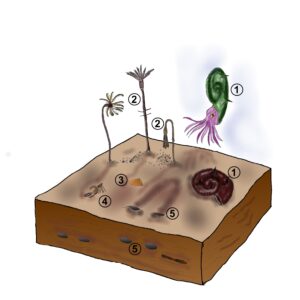
Figure 2. A reconstruction of the palaeoenvironment with Tirolites idrianus during the Early Triassic period; Legend: 1 – ammonites Tirolites idrianus, 2 – crinoids (Holocrinidae), 3 – bivalvia Costatoria costata, 4 – fish bone remains, 5 – ichnofossil Rhizocorallium sp. (Depiction: Matija Križnar, 2011)
In later parts of the Triassic, vast carbonate platforms were formed mostly at the edges of the Neotethys and Paleotethys Oceans, and the Cimmerian plate (Golonka 2007; Žalohar 2010). Algal and coral reef limestones were formed, as well as shallow water platform limestones and dolomites; these are also present in the Idrija region, where the aforementioned Middle Triassic rocks contain fossils of the ammonites Trachyceras idrianum and Joannites deschmani, the bivalve Posidonia idriana, and the brachiopod Lingula lipoldi. The Late Triassic of the Idrija Geopark also contains a varied array of bivalves, including Myophoria kefersteini, Pachycardia rugosa, and Triadomegalodon idrianus (Table 1).
Table 1. A selected list of Triassic marine fossils from the vicinity of the Idrija Geopark. Data from Hauer 1865; Mojsisovics 1882; and Pleničar et al. 2009.
Epoch | Fossil | |||||
Bivalvia | Gastropoda | Ammonites | Corals | Brachiopoda | Ichnofossil | |
Upper Triassic | Myophoria kefersteini |
| Trachyceras aon | Volzeia badiotica |
|
|
Pachycardia rugosa |
| Protrachyceras rutorarum |
|
|
| |
Hoernesia bipartita |
|
|
|
|
| |
Neomegalodon triqueter |
|
|
|
|
| |
Triadomegalodon idrianus |
|
|
|
|
| |
Middle Triassic | Daonella lommeli |
| Protrachyceras archelaus |
| cf. Discina sp. |
|
Daonella (Arzelella) cf. tripartita | Trachyceras idrianum |
| Lingula lipoldi |
| ||
Posidonia wengensis | Trachyceras julium |
|
|
| ||
Posidonomya idriana | Joannites deschmani |
|
|
| ||
| Arcestes (Proarcestes) esinensis |
|
|
| ||
| Arpadites arpadis |
|
|
| ||
| Reitziites reitzi |
|
|
| ||
|
| Megaphyllites oenipontanus |
|
|
| |
Lower Triassic | Costatoria costata | Werfenella rectecostata | Tirolites idrianus |
|
| Rhizocorallium jenense |
Claraia claraia | Natiria costata | Tirolites carniolicus |
|
|
| |
Pseudomonotis (Claraia) aurita |
| Tirolites cassianus |
|
|
| |
Pseudomonotis (Eumorphotis) lipoldi |
| Tirolites mercurii |
|
|
| |
Anodontophora (Myacites) fassaensis |
| Dinarites muchianus |
|
|
| |
|
| Dinarites cf. dalmatinus |
|
|
| |
Type Locality, Taxonomy and Stratigraphic Distribution of Tirolites idrianus
The ammonite Tirolites idrianus from the Idrija region was first documented by Hauer (1865) (Fig. 1), who named it Ceratites idrianus. As its type locality, he listed the settlement of Zagodov Vrh (Fig. 3) to the southeast of Idrija (Hauer 1865; Mojsisovics 1882). The status of Zagodov Vrh as a type locality can be inferred based on a documented and illustrated case of a Tirolites idrianus discovered at this location (Hauer 1865). However, the exact location and collection of this holotype are unknown.
As other locations in the Idrija region where Tirolites idrianus is present, Hauer (1865) lists a ravine south of Lazec above the Idrijca River Valley and the settlement of Izgorje near Žiri (Fig. 3). After extensive studies and comparisons of numerous specimens, Mojsisovics (1882) divided the genus Ceratites into three new genera, Ceratites, Dinarites, and Tirolites. He renamed the idrianus species as Tirolites idrianus and classified the specimens with a wider cross-section as a new species, Tirolites mercuri (Cigale 1977).
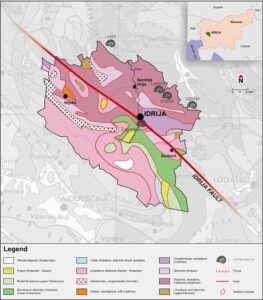
Figure 3. A simplified geological map of the Idrija UNESCO Global Geopark with the main locations of Tirolites idrianus (the geological map was adapted from Buser & Draksler 1993).
Tirolites idrianus is characterized by conspicuous ribs and by 2–5 (usually 3–4) spines and/or nodes on the last whorl (Posenato 1992) (Fig. 4). The shell of Tirolites idrianus is less involute compared to Tirolites carniolicus. It has a narrower cross-section and a faster growth process of the whorls that differentiates the species Tirolites idrianus from Tirolites mercurii (Mojsisovics 1882; Cigale 1977). Posenato (1992) reviewed Tirolites from the Dolomites (Italy), Bakony (Hungary), and Dalmatia (Croatia). He categorized Tirolites idrianus as one of the younger species from the Early Triassic, along with Tirolites carniolicus (Posenato 1992), which is characterized by a larger shell with fewer spines/nodes on the final whorl.
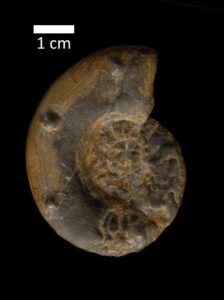
Figure 4. Ammonite fossil of the species Tirolites idrianus from Vrsnik, Bojan Režun’s private collection, Idrija. (Photo: Jani Peternelj, CUDHg Archive, 2012)
Tirolites is one of the most important ammonite remnants from the upper parts of the Early Triassic layers in Slovenia. Numerous species have been identified, such as Tirolites cassianus, Tirolites spinosus, Tirolites carniolicus, Tirolites haueri, and Tirolites stachei (Pavšič 2003). In the Idrija Geopark, several specimens of Tirolites idrianus have been found in the area of Vrsnik (Fig. 3), including the ammonite in Figure 4, part of the private collection. Aside from the Vrsnik site, Tirolites idrianus fossils have also been discovered on the Ledine Plateau (Fig. 5) and in Zagodov Vrh, southeast of Idrija (Fig. 1).
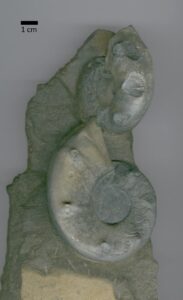
Figure 5. An ammonite fossil of the species Tirolites idrianus from the Ledine fossil site. Private collection of Goran Velikonja, Idrija. (Photo: Matija Križnar 2009)
In Slovenia, based on the legislation on the designation and protection of valuable natural features (The Official Gazette of the Republic of Slovenia 111/04, 70/06, 58/09, 93/10, 23/15, and 7/19), cephalopod fossils are treated as valuable natural features if more than half of their shell or half of their cast is preserved.
The Idrija Geopark currently has no ammonite fossil site with a natural value status. The ammonite finds in the Idrija Geopark are kept in private collections, so there is no clear overview of the actual number of finds. In addition, many ammonite fossils are not classified by experts, which possibly leads to them being misclassified as ammonites of other species, e. g. Tirolites cassianus.
What Features Make the Tirolites idrianus a Geological Heritage?
European scientists, who moved to Idrija because of the mercury mine, focused their research not only on their work in the mining activities but also on the area of Idrija in general. In this period, the first geological maps of the region were made, numerous fossils were discovered, and the local fauna and flora were documented. It is known that Johannes Antonius Scopoli, who worked for the mine as a doctor between 1754 and 1769, corresponded with Carl Linnaeus (Soban 2004), the father of modern taxonomy. Together, they classified numerous plant and animal species. In the 18th century, Idrija was thus a town where the foundations of Slovenian natural sciences were set.
After the closing of the mine in 1995, Idrija lost its global importance as a source of mercury. However, from an economic point of view, the town did not suffer because of the rise of two large technology companies. Today, the heritage of the mercury mine is maintained by the Centre for the Conservation of the Mercury Heritage of Idrija (CUDHg Idrija), while the conservation, interpretation and promotion of the natural heritage of the whole Idrija region fall to the Idrija UNESCO Global Geopark, which organizes a wide range of activities to present the natural and cultural heritage of Idrija to visitors. In 2019, the Idrija Geopark established a Visitor Centre, where many geological treasures of Idrija are on display, including Tirolites idrianus (Fig. 6).
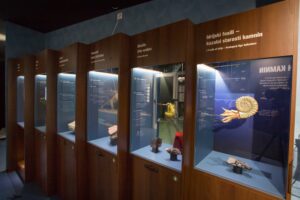
Figure 6. The Tirolites idrianus ammonite featured in the exhibit titled “Written in the rocks” in the Idrija Geopark Visitor Center. (Photo: Bojan Tavčar 2020)
Tirolites idrianus may not be as spectacular as other ammonite fossils, but it had a key role in the development of the natural sciences in Slovenia. Further, it is the index fossil for the Tirolites-Columbites Assemblage Zone of the Olenekian (early Spathian) in the Early Triassic, a zone that is recognized worldwide, from Europe to Asia (Russia, China, Japan, Vietnam).
The index fossils are characterized by the fact that they lived in a relatively short time in a geological period, but they inhabited a rather large living environment. Based on their findings in a specific rock, we can accurately determine the age of the rock.
Geotourism and Geotrail Potential
Slovenian legislation, namely the Nature Conservation Act, does not mandate reporting finds to the Institute of the Republic of Slovenia for Nature Conservation nor does it address the possibility of reclamation, adequate conservation, and protection of small-scale Tirolites idrianus fossil sites in Idrija. For this reason, the fossil sites are not documented on any tourist map and are not widely known, so neither independent nor guided tours of the Tirolites idrianus sites are currently possible in the Idrija Geopark. The Tirolites idrianus ammonite and its story are described in the new exhibit titled “Written in the rocks” at the Idrija Geopark Visitor Centre. The exhibit also features a replica of the ammonite fossil find from Ledine (Fig. 5).
Tirolites idrianus is also frequently the focus of various educational activities and workshops we organize for schools or other educational institutions. Through a short presentation, the students learn what fossils are and how they are formed. They also learn about the characteristics of ammonites and the role Tirolites idrianus played in the history of Idrija. At the end of the workshop, the students craft their souvenirs (e.g., refrigerator magnets, brooch pins, pendants, earrings) in the shape of the ammonite (Fig. 7). The models used are replicas of actual fossil finds from Idrija area. Such replicas of the Tirolites idrianus ammonite fossils could perhaps be sold as a geoproduct at the Idrija Geopark Visitor Centre or serve as a basis for the development of geoproducts for the collective “Idrija – selected” trademark (“Idrija – izbrano” in Slovenian), which was established in 2018. The trademark includes products based on innovative techniques, quality, tradition, and local heritage.
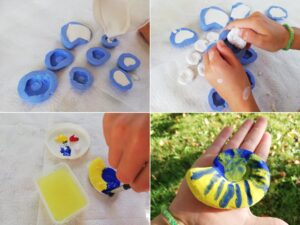
Figure 7. A workshop for crafting plaster cast replicas of the Tirolites idrianus ammonite. (Photo: Mojca Gorjup Kavčič 2020)
The Idrija Lace School, the role of which is to conserve the lace-making tradition of Idrija, has included the ammonite motif in its lace-making curriculum. The ammonite-shaped pattern is copyright of the Idrija Lace School and is available to all students who wish to make an ammonite-shaped lace in the course of their studies (Fig. 8).
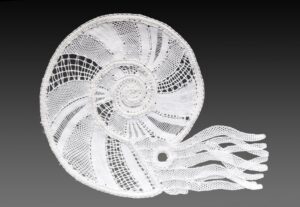
Figure 8. Idrija lace in the shape of an Ammonite. Lacemaker: Ana Fajdiga, Idrija Lace School, Unit of Vipava. Mentor: Katarina Mlakar. (Photo: Bojan Tavčar 2019)
The Conservation of the Tirolites idrianus Geosites: Actions, Solutions, and Limitations
Potential tourist activity is not considered detrimental to the Tirolites idrianus sites. A much greater problem is posed by private collectors who independently carry out fossil hunts to find specimens for their private collections and do not (and are not obligated to) report their discoveries to the relevant research institutions. In certain cases, rumors of a fossil site spread in the fossil collector community, which leads to the fossil site being depleted. In terms of legislation, these issues are still very loosely regulated in Slovenia, which is why it is necessary to amend the Nature Conservation Act to cover such cases as well.
Another problem is the scientific classification of the fossil finds. As already mentioned, it is possible to discriminate between Tirolites idrianus and Tirolites mercuri, but it is unclear whether amateur collectors regularly discriminate between these two species.
So far, there has been no systematic overview and exact documentation of the discovered specimens. The Idrija Geopark is of course in favor of a systematic solution to this issue, but this has not yet been done. The idea is to organize a workshop with all the private collectors to create a registry of private collections and document their minerals and fossils. The success of such a workshop is of course questionable as many collectors do not wish to present their finds to the public, particularly those who have had previous negative experiences.
Conclusion
In the 18th century, Idrija was a town where the foundations of Slovenian natural sciences were set. Today, it plays a different role, with new potential. Mining ended in the 1990s, and since then, its institutions have turned to the protection, interpretation, and promotion of its heritage. The heritage of the Idrija mercury mine was inscribed on the UNESCO World Heritage List in 2012, along with the mercury mine in Almadén, Spain. The region of the Municipality of Idrija, with its natural and cultural heritage and its manner of representing and connecting diverse rural stakeholders, was granted the status of a European and global geopark in 2013 and was declared a UNESCO Global Geopark in 2015. All these titles confirm that the region of Idrija is unique in a global sense.
The importance of the Tirolites idrianus ammonite in the Idrija Geopark lies in the fact that the find serves as a basis to educate visitors on the role of Idrija in the development of natural sciences in Slovenia, as well as the importance of the mercury mine for the development of the world in general. This creates excellent conditions for the development of geotourism and geoproducts, both artisan products and experiences, which are particularly popular today. Some of these ideas have already been realized in the Idrija Geopark Visitor Centre and through different workshops, but some ambitious plans remain for the future.
Conflict of Interest
The authors declare that there is no conflict of interest in their work.
